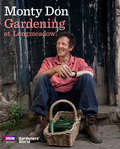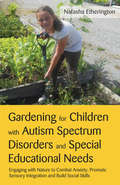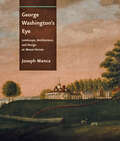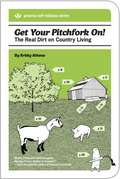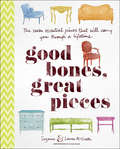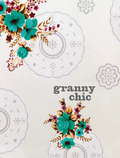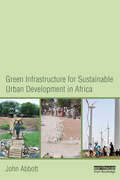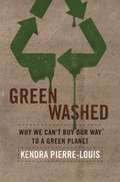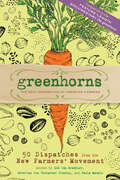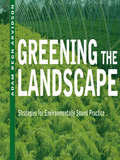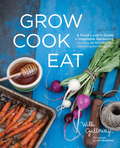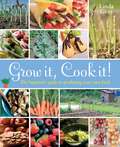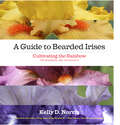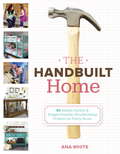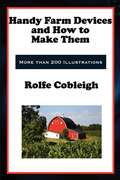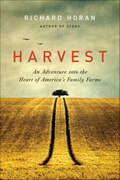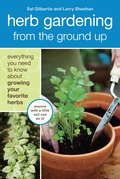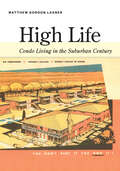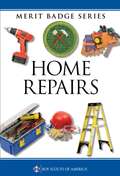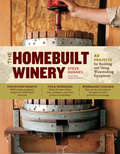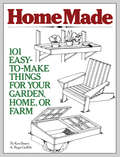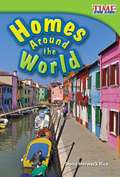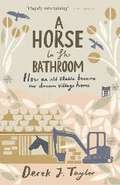- Table View
- List View
Gardening at Longmeadow
by Monty DonMonty Don made a triumphant return to our screens as presenter of Gardeners' World. A firm favourite with viewers, Monty's infectious enthusiasm for plants, attention to the finer details of gardening technique and easy charm have seen the ratings soar. Here Monty invites us into the garden at Longmeadow, to show us how he created this beautiful garden, and how we can do the same in our own.Following the cycle of the seasons, Gardening at Longmeadow will introduce readers to the garden from the earliest snowdrops of January through the first splashes of colour in the Spring Garden, the electric summer displays of the Jewel Garden, the autumn harvest in the orchard, and on to a Christmas feast sourced from the vegetable gardens. Describing the magic of each area at different times of the year, Monty will explain the basics of what to do when and how to get the most from each plant. He'll talk through the essential techniques and more complex processes, accompanied by easy-to-follow, step-by-step photography.Longmeadow is a gardeners' garden, but this will be a book for gardening enthusiasts of all skill levels who have been inspired by what they've seen, and who would like to achieve something similar for themselves.
Gardening for Children with Autism Spectrum Disorders and Special Educational Needs
by Natasha Etheringtonxx
George Washington's Eye: Landscape, Architecture, and Design at Mount Vernon
by Joseph MancaExplore the beauty and history of Mount Vernon—and the inquisitive, independent mind of its famous architect and landscape designer.Winner of the John Brinkerhoff Jackson Book Prize of the Foundation for Landscape ArchitectureOn the banks of the Potomac River, Mount Vernon stands, with its iconic portico boasting breathtaking views and with a landscape to rival the great gardens of Europe, as a monument to George Washington’s artistic and creative efforts. More than one million people visit Mount Vernon each year—drawn to the stature and beauty of Washington’s family estate.Art historian Joseph Manca systematically examines Mount Vernon—its stylistic, moral, and historical dimensions—offering a complete picture of this national treasure and the man behind its enduring design. Manca brings to light a Washington deeply influenced by his wide travels in colonial America, with a broader architectural knowledge than previously suspected, and with a philosophy that informed his aesthetic sensibility. Washington believed that design choices and personal character mesh to form an ethic of virtue and fulfillment and that art is inextricably linked with moral and social concerns. Manca examines how these ideas shaped the material culture of Mount Vernon.Based on careful study of Washington’s personal diaries and correspondence and on the lively accounts of visitors to his estate, this richly illustrated book introduces a George Washington unfamiliar to many readers—an avid art collector, amateur architect, and leading landscape designer of his time.
Get Your Pitchfork On!
by Kristy AthensFor hard-working office workers Kristy Athens and husband Michael, farming was a romantic dream. After purchasing farm land in Oregon's beautiful Columbia Gorge, Athens and hubby were surprised to learn that the realities of farming were challenging and unexpected. Get Your Pitchfork On! provides the hard-learned nuts-and-bolts of rural living from city folk who were initially out of their depth. Practical and often hilarious, Get Your Pitchfork On! reads like a twenty-first century Egg and I. Get Your Pitchfork On! gives urban professionals the practical tools they need to realize their dream, with basics of home, farm, and hearth. It also enters territory that other books avoid--straightforward advice about the social aspects of country living, from health care to schools to small-town politics. Kristy Athens doesn't shy away from controversial subjects, such as having guns and hiring undocumented migrant workers. An important difference between Get Your Pitchfork On! and other farm/country books is that the author's initial country experiment failed. Ravaged by the elements, the economy, and the social structure of their rural area, Athens and husband sold their farm and retreated to Portland, Oregon, in 2009. This gave Athens the freedom to write honestly about her extraordinary experience. Having learned from mistakes, both Kristy and her husband are currently saving up to buy another farm, and this time to live a practical dream rather than an uninformed nightmare. Kristy Athens' nonfiction and short stories have been published in a number of magazines, newspapers, and literary journals, most recently High Desert Journal, Barely South Review, and the anthology Mamas and Papas. In 2010, she was a writer-in-residence for the Eastern Oregon Writer-in-Residence program and Soapstone. This is her first book.
Good Bones, Great Pieces: The Seven Essential Pieces That Will Carry You Through A Lifetime
by Suzanne McGrath Lauren McGrath Lucas Allen“An excellent and useful book for both beginners and more experienced home decorators . . . encourages us all to be both carefree and careful” (Martha Stewart). Making a home is a lifelong pursuit and it starts with your very first place. Suzanne and Lauren McGrath, a mother–daughter team, operate the popular blog Good Bones, Great Pieces. At the core of their philosophy is the belief that every home should have seven essential pieces that can live in almost any room and will always be stylish. The authors explain how to place iconic items of furniture like the love seat and the dresser and rotate them throughout the home as the style or need changes. Illustrated with photographs of homes and apartments that the McGraths have designed, as well as apartments by some iconic designers, this book is a wonderful resource, whether you are starting out with your first apartment or rethinking the design of your home. “A must-read for first-timers and seasoned home decorators alike.” —Traditional Home
Granny Chic: Crafty recipes and inspiration for the handmade home
by Tif Fussell Rachelle BlondelMore than just a 'how-to' guide, Granny Chic offers inspiration to keen crafters hoping to breathe new life into vintage fabrics and second-hand objects. From handmade notebooks to lace lampshades and pinnies made from tea towels, each of the craft 'recipes' brings the granny chic look to life while allowing you to give them your own personal twist. This selection of 20 projects includes spruced-up coat hangers, a 'dingle dangle' door screen, a 'patched and pieced' lampshade and a crocheted tea cosy. In addition to the projects, Granny Chic offers advice on the granny chic lifestyle, from befriending your local fabric shop to creating a handmade home. Packed full of ideas, it will have you rustling in your vintage fabric to find your inner granny chic crafting soul.
Green Infrastructure for Sustainable Urban Development in Africa
by John AbbottThis book shows for the first time how green infrastructure can work in an African urban context. On one level it provides a major rethinking of the role of infrastructure in urban society since the creation of networked infrastructure in the early twentieth century. On another, it explores the changing paradigms of urban development through the fundamental question of how decisions are made. With a focus on Africa's fast-growing secondary towns, where 70 per cent of the urban population live, the book explains how urban infrastructure provides the key to the relationship between economic development and social equity, through the mediation of natural resources. Adopting this view enables investment to be channelled more effectively to provide the engine for economic growth, while providing equitable services for all residents. At the same time, the mediation of resource flows integrates the metabolism of the city into the wider ecosystem. This vision leads to a new way of thinking about infrastructure, giving clear definition to the concept of green infrastructure. On the basis of research gathered throughout an extensive career, John Abbott draws in particular from his experience in Ethiopia to demonstrate the ways in which infrastructure needs to respond to the economies, societies and natural environments of twenty-first century urban Africa.
Green Washed
by Kendra Pierre-LouisThe message that our environment is in peril has filtered from environmental groups to theAmerican consciousness to our shopping carts. Every day, millions of Americans dutifully replace conventional produce with organic, swap Mr. Clean for Seventh Generation, and replace their bottled water with water bottles. Many of us have come to believe that the path to environmental sustainability is paved by shopping green. Although this green consumer movement certainly has many Americans consuming differently, it raises an important and rarely asked question--"is this consumption really any better for the planet?" By examining the major economic sectors of our society, including infrastructure (green housing), consumer goods (green clothing and jewelry), food (the rise of organic), and energy (including solar power and the popularity of the hybrid car), Green Washed: Why We Can't Buy Our Way to a Green Planet explains that, though greener alternatives are important, we cannot simply buy our way to sustainability. Rather, if it is the volume of our consumption that matters, can we as a society dependent on constantly consuming ever be content with buying less? A new and unique take on green consumption, Green Washed shows how buying better is only the first step toward true sustainability. Kendra Pierre-Louis is the sustainable development editor for Justmeans.com. She holds a master's degree in sustainable development from the SIT Graduate Institute in Vermont. She has created outreach material for the United Nations Environment Programme's Convention on Biological Diversity and worked as a researcher for Terrapin Bright Green, an environmental consulting and strategic planning firm.
Greenhorns: 50 Dispatches from the New Farmers' Movement
by Zoe Ida Bradbury Severine Von Fleming Paula ManaloThe Greenhorns are a community of more than 5,000 young farmers and activists committed to producing and advocating for food grown with vision and respect for the earth. <P><P>This book, edited by three of the group’s leading members, comprises 50 original essays by new farmers who write about their experiences in the field from a wide range of angles, both practical and inspirational. <P><P>Funny and sad, serious and light-hearted, these essays touch on everything from financing and machinery to family, community building, and social change.
Greening the Landscape: Strategies for Environmentally Sound Practice
by Adam Regn ArvidsonA guide to improving the environmental performance of any landscape through the use of green construction and maintenance. Landscapes create obvious environmental benefits but can have unrecognized negative impacts. Adam Regn Arvidson outlines the five primary problem issues--plant pots, vehicle fuel, energy consumption, water/fertilizer use, and green waste--and details a variety of practices, ranging from exceedingly simple ideas to long-term investments, for making the installation and upkeep of landscapes more green. A companion website, GreeningtheLandscapeBook.com, provides readers with additional resources and case studies, arranged by environmental impact and geography.
Grow Cook Eat
by Jim Henkins Willi GallowayFrom sinking a seed into the soil through to sitting down to enjoy a meal made with vegetables and fruits harvested right outside your back door, this gorgeous kitchen gardening book is filled with practical, useful information for both novices and seasoned gardeners alike. Grow Cook Eatwill inspire people who already buy fresh, seasonal, local, organic food to grow the food they love to eat. For those who already have experience getting their hands dirty in the garden, this handbook will help them refine their gardening skills and cultivate gourmet quality food. The book also fills in the blanks that exist between growing food in the garden and using it in the kitchen with guides to 50 of the best-loved, tastiest vegetables, herbs, and small fruits. The guides give readers easy-to-follow planting and growing information, specific instructions for harvesting all the edible parts of the plant, advice on storing food in a way that maximizes flavor, basic preparation techniques, and recipes. The recipes at the end of each guide help readers explore the foods they grow and demonstrate how to use unusual foods, like radish greens, garlic scapes, and green coriander seeds.
Grow It, Cook It!: The Beginner's Guide to Producing Your Own Food
by Linda GrayMany crops, including herbs, can be produced in a relatively small space with a little pre-planning and organizing: in containers, on a balcony, and indoors. Herbs are perfect for enhancing the flavour of cooking, treating minor ailments, and preventing colds and flu. Your own back garden will not only produce the best food on the planet for you and your loved ones, it is also economical, environmentally friendly and more fun than shopping. Gardening is more than a hobby; it's a way of life. This book provides all the information you need to keep your family and friends healthy, fit and enjoying life to the full.
A Guide to Bearded Irises: Cultivating the Rainbow for Beginners and Enthusiasts
by Kelly NorrisThe diversity of bearded irises rivals that of any other perennial grown in temperate climates. For some gardeners, they bring back warm memories of a grandparent's garden; for others, they're a cutting-edge plant with a seemingly endless capacity for producing new forms and patterns.As the manager of Rainbow Iris Farm and co-editor of the Bulletin of the American Iris Society, Kelly Norris is the authority on gardening with bearded irises. His introductory chapters offer tips for successful growth, garden design, plant selection, and "creating" new irises. A Guide to Bearded Irises also provides portraits of the most outstanding plants in each of the six recognized categories, from the dainty miniature dwarf bearded irises to the stately tall bearded irises. A resource section lists specialty nurseries, organizations devoted to bearded irises, and public gardens with notable iris collections.
The Handbuilt Home: 34 Simple Stylish and Budget-Friendly Woodworking Projects for Every Room
by Ana WhiteCreate a Beautiful, Modern Home with One-of-a-Kind DIY FurnitureBeds, organizers, Adirondack chairs, a play table, and more! It's easy to build inexpensive, quality furnishings with this indispensible collection of woodworking projects from Ana White, the popular blogger who has inspired millions of homemakers with her stylish furniture plans and DIY spirit. As a young mom on a tight budget, Ana learned to make her own well-designed pieces inspired by the styles in her favorite stores--saving thousands of dollars in the process.Now, in this reference for woodworkers of all skill levels, Ana shares everything she has learned along the way. Inside The Handbuilt Home you'll find:* Plans for 34 versatile furniture projects for every room in your house--from beginner-friendly home accessories to sturdy tables, a media center, kids' items, and storage solutions* Comprehensive information on using off-the-shelf lumber and basic equipment--almost every project can be made with a drill, a saw, and some hand tools* Easy-to-follow instructions, costs, and time estimates to guide even the most amateur of carpenters through any projectYou don't need to be physically tough or superstrong to make your own furniture, and it's okay if you don't know that a 2x4 doesn't actually measure 2 by 4 inches. All you need is the determination to create a better home for yourself or your family and the confidence to say, "I can build that." Also available as an eBook
Handy Farm Devices and How to Make Them
by Rolfe CobleighA wonderful book for anyone interested in starting their own homestead or small farm. This book will show you how to be self reliant and build the things you'll need. There are more than 200 illustrations showing you how to make handy farm devices. You'll learn about the farmer's workshop and tools, running a grindstone, making a dumb waiter, making a cradle, how to clean a well, how to stake out stock, bee keeping, how to transplant trees, how to build a bridge for a small stream, how to keep a gate from sagging, important points in house building, how to build small greenhouses, advice on the best way to split wood, black smithing, and much, much more in this thrift-conscious and environmentally wise book.
Harvest: An Adventure into the Heart of America's Family Farms
by Richard Horan“Richard Horan has brought us a welcome view of America to defy the prevailing political and financial nastiness. This is a timely and important book.”—Ted Morgan, author of Wilderness at Dawn“A lively visit with the dauntless men and women who operate America’s family farms and help provide our miraculous annual bounty. Richard Horan writes with energy and passion.”—Hannah Nordhaus, author of The Beekeeper’s Lament“Horan’s new book evocatively describes the peril and promise of family farms in America. I loved joining him on this journey, and so will you.”—T.A. Barron, author of The Great Tree of AvalonIn Seeds, novelist and nature writer Richard Horan sought out the trees that inspired the work of great American writers like Faulkner, Kerouac, Welty, Wharton, and Harper Lee. In Harvest, Horan embarks upon a serendipitous journey across America to work the harvests of more than a dozen essential or unusual food crops—and, in the process, forms powerful connections with the farmers, the soil, and the seasons.
Herb Gardening from the Ground Up
by Sal Gilbertie Lauren Jarrett Larry SheehanGarden-fresh herbs impart flavor and fragrance that dried, packaged products simply can't. Now, anyone with access to a few square yards of soil (or even a sunny patio or windowsill) can enjoy the punch and pungency that only come from fresh herbs, hand-picked from the garden. Herb Gardening from the Ground Up demonstrates how to design, seed, and nurture 38 culinary herb gardens that are delightful to the eye as well the palate. Designed to supply herbs for a wide range of flavors as well as a pleasing balance of colors, there are gardens to suit every taste and cooking trend, including a French chef's repertoire, an Italian trattoria's menu, the aromatic seasonings of Asia, the closer-to-home flavors of American barbecue, and the piquant profiles for a Tex-Mex feast. There are herbs for flavoring fish and game, soups and salads, bread and other baked goods, and, for the mixologists among us, even herbs for the home cocktail bar. Herb Gardening from the Ground Up offers historical insight, provides starting-from-scratch, season-to-season basics for planting in the present, and looks forward to the bright future of urban and suburban growing trends.
High Life: Condo Living in the Suburban Century
by Matthew LasnerThe first comprehensive architectural and cultural history of condominium and cooperative housing in twentieth-century America. Today, one in five homeowners in American cities and suburbs lives in a multifamily home rather than a single-family house. As the American dream evolves, precipitated by rising real estate prices and a renewed interest in urban living, many predict that condos will become the predominant form of housing in the twenty-first century. In this unprecedented study, Matthew Gordon Lasner explores the history of co-owned multifamily housing in the United States, from New York City’s first co-op, in 1881, to contemporary condominium and townhouse complexes coast to coast. Lasner explains the complicated social, economic, and political factors that have increased demand for this way of living, situating the trend within the larger housing market and broad shifts in residential architecture and family life. He contrasts the prevalence and popularity of condos, townhouses, and other privately governed communities with their ambiguous economic, legal, and social standing, as well as their striking absence from urban and architectural history.
Home Repairs (Merit Badge)
by Boy Scouts of America StaffHOME REPAIRS MERIT BADGE PAMPHLET BOY SCOUTS OF AMERICA MERIT BADGE SERIES "Enhancing our youths' competitive edge through merit badges"
The Homebuilt Winery: 43 Projects for Building and Using Winemaking Equipment
by Steve HughesBuild your own winery! Learn how to set up a home winery and construct all the basic equipment for just a fraction of what commercially manufactured products would cost. <P><P> Leading you through the entire winemaking process, Steve Hughes includes building plans and step-by-step instructions for making more than 30 essential winemaking tools. <P><P>From fashioning presses and pumps to the best way to fill and cork bottles, The Homebuilt Winery covers everything you need to know to affordably enjoy delicious, high-quality homemade wine.
HomeMade: 101 Easy-to-Make Things for Your Garden, Home, or Farm
by Ken Braren Roger GriffithDiscover the satisfaction of building your own lawn chairs, fences, bootjacks, cold frames, and compost bins. <P><P>Ken Braren and Roger Griffith show you how to build a variety of easy-to-make items for your home and garden that are designed to save you money and make your life easier. <P><P>Even if you have limited construction experience, the simple instructions and clear illustrations in this guide will have you confidently crafting your own potting bench and building a basement closet.
Homes Around The World (Time For Kids® Nonfiction Readers Ser.)
by Dona Herweck RiceLearn about the different places that people call home--from apartments to cottages and castles to farmhouses. With bright, vivid photos and easy-to-read informational text, readers are introduced to different cultures' definitions of "home."
A Horse in the Bathroom: How an Old Stable Became Our Dream Village Home
by Derek J. TaylorWhen Derek and Maggie decide to escape to the country, they set about converting an old Cotswold stables into their dream home. Over the next two years, they wage guerrilla war on the Planning Office, are cursed by collapsing walls and poison gas, run out of money, and meet some very strange characters.
A Horse in the Bathroom: How an Old Stable Became Our Dream Village Home
by Derek J. TaylorWhen Derek and Maggie decide to escape to the country, they set about converting an old Cotswold stables into their dream home. Over the next two years, they wage guerrilla war on the Planning Office, are cursed by collapsing walls and poison gas, run out of money, and meet some very strange characters.
Houses Made of Wood and Light: The Life and Architecture of Hank Schubart
by Michele Dunkerley Jane HickieAmerican architect Hank Schubart was regarded as a genius for finding the perfect site for a house and for integrating its design into the natural setting, so that his houses appear to be as native to the forest around them as the trees and rocks. Salt Spring Island, one of the Gulf Islands in British Columbia, Canada, offered him a place to create the kind of architecture that responded to its surroundings, and Schubart-designed homes populate the island. Built of wood and glass, suffused with light, and oriented to views, they display characteristic features: random-width cedar siding, exposed beams, rusticated stonework. Over time, Schubart's homes on Salt Spring Island came to be considered uniquely Gulf Islands homes. This inviting book offers the first introduction to the life and architecture of West Coast modernist Henry A. Schubart, Jr. (1916-1998). While still in his teens, Schubart persuaded Frank Lloyd Wright to accept him as a Taliesin Fellow, and his year's apprenticeship in the master's workshop taught him principles of designing in harmony with nature that he explored throughout the rest of his life. Michele Dunkerley traces Schubart's career from his early practice in San Francisco at the noted firm Wurster, Bernardi & Emmons, to his successful firm with Howard Friedman, to his most lasting professional achievements on Salt Spring Island, where he became the de facto community architect, designing more than 230 residential, commercial, educational, and religious projects. Drawing lessons from his mentors over his decades on the island, he forged an everyday architecture with his mastery of detail and inventiveness. In doing so, he helped define how the island could grow without losing its soul. Color photographs and site plans display Schubart's remarkable homes and other commissions.
